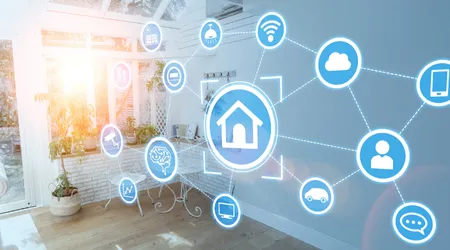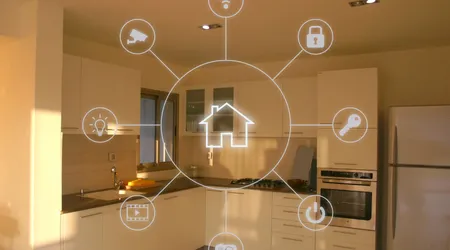Home Automation on a Budget: DIY Solutions

In today’s fast-paced world, home automation on a budget is no longer a luxury reserved for the tech-savvy elite.
With the rise of affordable smart devices and DIY solutions, anyone can turn their home into a connected haven without breaking the bank.
Whether you’re looking to enhance security, save energy, or simply add a touch of modern convenience, this guide will walk you through practical, cost-effective ways to achieve home automation on a budget.
Additionally, the growing community of DIY enthusiasts and online resources makes it easier than ever to find guidance and inspiration.
From tutorials to forums, you can connect with others who share your passion for smart home technology, learning from their experiences and insights.
Why Home Automation Matters in 2023
The global smart home market is projected to reach $135 billion by 2025, according to Statista.
This staggering growth reflects the increasing demand for connected living spaces.
But what if you’re not ready to invest thousands of dollars in professional installations?
The good news is that you don’t have to.
With a little creativity and some strategic planning, you can achieve a fully automated home for a fraction of the cost.
Moreover, home automation can enhance your quality of life by providing convenience and efficiency.
From controlling your lights with a voice command to automating your heating, the benefits are numerous.
As technology advances, the options for budget-friendly automation will only expand, making it an exciting time to get started.
+ Smart Home Hubs: Choosing the Right System
Start Small: Smart Plugs and Bulbs
One of the easiest ways to dip your toes into home automation on a budget is by investing in smart plugs and bulbs.
These devices are not only affordable but also incredibly versatile.
Smart plugs allow you to control any appliance remotely, while smart bulbs can be programmed to change colors, dim, or turn on/off based on your schedule.
Table 1: Cost Comparison of Smart Plugs and Bulbs
| Device | Average Cost | Key Features |
|---|---|---|
| Smart Plug | $15–$25 | Remote control, energy monitoring |
| Smart Bulb | $10–$30 | Color changing, scheduling |
For example, a $20 smart plug can turn your coffee maker into a smart device, ensuring your morning brew is ready as soon as you wake up.
Similarly, a $15 smart bulb can create the perfect ambiance for movie night with just a tap on your smartphone.
Additionally, these devices can help you track energy usage and identify appliances that consume the most power.
This awareness can lead to smarter choices, ultimately saving you money on your utility bills.
Voice Assistants: The Brain of Your Smart Home
No discussion about home automation on a budget is complete without mentioning voice assistants.
Devices like Amazon Echo Dot and Google Nest Mini are affordable entry points into the world of voice-controlled automation.
These compact gadgets act as the central hub for your smart devices, allowing you to control everything with simple voice commands.
Imagine saying, “Goodnight,” and having your lights turn off, your thermostat adjust, and your doors lock automatically.
With a voice assistant, this level of convenience is well within reach.
Furthermore, voice assistants often integrate with a wide range of smart devices, enhancing their functionality.
You can create routines that automate multiple actions with a single command, streamlining your daily tasks even further.
DIY Security: Peace of Mind Without the High Cost
Home security is often a top priority for homeowners, but professional systems can be prohibitively expensive.
Fortunately, there are plenty of DIY solutions that offer robust protection without the hefty price tag.
Smart cameras, door sensors, and motion detectors are now more affordable than ever, and many can be installed in under an hour.
Table 2: DIY Security Devices and Their Features
| Device | Average Cost | Key Features |
|---|---|---|
| Smart Camera | $50–$150 | Live streaming, motion alerts |
| Door/Window Sensor | $20–$40 | Instant notifications, easy install |
| Motion Detector | $30–$60 | Customizable sensitivity |
For instance, a $60 smart camera can provide 24/7 surveillance and send real-time alerts to your phone, while a $25 door sensor can notify you the moment someone enters your home.
These devices not only enhance security but also integrate seamlessly with other smart home systems.
Moreover, many DIY security devices come with mobile apps that allow you to monitor your home from anywhere.
This level of control offers peace of mind, knowing that you can check in on your property at any time.

Energy Efficiency: Save Money While Automating
One of the most compelling reasons to embrace home automation on a budget is the potential for energy savings.
Smart thermostats, like the Nest Thermostat E or Ecobee SmartThermostat, learn your habits and adjust the temperature accordingly, reducing energy waste and lowering your utility bills.
Additionally, smart power strips can cut off power to devices that are in standby mode, preventing “phantom energy” consumption.
Over time, these small changes can add up to significant savings, making your investment in home automation even more worthwhile.
Furthermore, many utility companies offer rebates for installing energy-efficient devices, which can further offset costs.
By taking advantage of these programs, you can make home automation even more budget-friendly.
Open-Source Platforms: The Ultimate DIY Hack
For those who love tinkering and customizing, open-source platforms like Home Assistant and OpenHAB offer unparalleled flexibility.
These platforms allow you to integrate a wide range of devices from different brands, creating a truly personalized smart home experience.
While they require a bit more technical know-how, the payoff is a system tailored to your exact needs—all without the high costs associated with proprietary solutions.
Moreover, the open-source community is vibrant and supportive, providing countless resources and forums for troubleshooting and advice.
This collaborative environment can enhance your learning experience as you explore the possibilities of home automation.
Additionally, many open-source platforms are regularly updated with new features and improvements, ensuring your system remains cutting-edge.
Investing time in learning these platforms can yield long-term benefits for your smart home setup.
The Role of Wi-Fi in Budget-Friendly Automation
A reliable Wi-Fi network is the backbone of any smart home.
Fortunately, most modern routers are more than capable of handling the demands of home automation on a budget.
If you’re experiencing connectivity issues, consider upgrading to a mesh Wi-Fi system, which can provide seamless coverage throughout your home.
Moreover, optimizing your network settings can significantly improve performance.
Adjusting your router’s placement and reducing interference from other devices can enhance connectivity for all your smart gadgets.
Additionally, consider setting up a guest network for visitors to keep your main network more secure.
This added layer of protection can help safeguard your devices from unauthorized access.
Common Pitfalls to Avoid
While DIY home automation is cost-effective, it’s not without its challenges.
One common mistake is overloading your network with too many devices, which can lead to sluggish performance.
To avoid this, prioritize devices that offer the most value and ensure your Wi-Fi network is optimized for multiple connections.
Another pitfall is neglecting compatibility.
Not all smart devices work well together, so it’s essential to research before making a purchase.
Stick to brands that support popular ecosystems like Amazon Alexa, Google Assistant, or Apple HomeKit to ensure smooth integration.
Furthermore, avoid impulse buying.
Take the time to assess your needs and plan your purchases strategically to ensure you’re investing in devices that truly enhance your home automation experience.

++ Energy-efficient smart homes: savings through technology
The Future of Home Automation on a Budget
As technology continues to evolve, the cost of smart devices is expected to decrease even further.
Innovations like Matter, a new universal smart home standard, promise to simplify compatibility and make home automation more accessible than ever.
This means that achieving a connected home on a budget will only get easier in the coming years.
Moreover, as consumer demand grows, manufacturers will likely introduce more budget-friendly options.
This shift will create a competitive market that benefits consumers with better products at lower prices.
Additionally, advancements in AI and machine learning will lead to smarter devices that can anticipate your needs, further enhancing the automation experience.
The future looks bright for those looking to automate their homes without overspending.
Final Thoughts: Smart Living Within Reach
Home automation on a budget is no longer a distant dream—it’s a reality that’s within reach for anyone willing to explore DIY solutions.
By starting small, leveraging affordable devices, and embracing open-source platforms, you can create a smart home that’s both functional and cost-effective.
So, whether you’re looking to enhance security, save energy, or simply add a touch of modern convenience, there’s never been a better time to dive into the world of home automation.
With a little creativity and some strategic planning, you can transform your living space into a connected haven without breaking the bank.
Remember, the journey of home automation is as much about enjoying the process as it is about the final result.
Embrace the challenges and celebrate your successes as you create a space that reflects your lifestyle and values.
